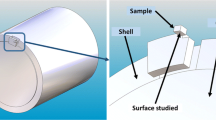We study the wear resistance, fatigue strength, and corrosion-fatigue strength of SShKhN-42 rolls made of cast iron with surface nanostructures obtained as a result of mechanical-pulse treatment under the operational conditions of rolls of the rolling mills. It is shown that the surface nanostructure makes the wear resistance of cast iron three times higher and almost doubles the fatigue strength. This type of behavior of cast irons with surface nanostructure is scientifically substantiated.





Similar content being viewed by others
References
V. Konovalenko, P. O. Marushchak, and O. N. Kuz’, “A method for processing and analysis of the images of a network of thermal fatigue cracks on the surfaces of rolls of continuous casting machines,” Fiz.-Khim. Mekh. Mater., 54, No. 2, 41–48 (2018); English translation: Mater. Sci., 54, No. 2, 175–183 (2018).
V. I. Kyryliv, B. P. Chaikovs’kyi, O. V. Maksymiv, A. V. Shal’ko, and P. Ya. Sydor, “Serviceability of 60Kh2M roll steel with surface nanostructure,” Fiz.-Khim. Mekh. Mater., 52, No. 6, 100–104 (2016); English translation: Mater. Sci., 52, No. 6, 848–853 (2016).
Yu. Zhiguts and V. Lazar, “Special grey and white termite cast irons,” Brit. J. Sci., Educ. Cult., 1, No. 2 (6), 201–207 (2014).
V. Kyryliv, Y. Kyryliv, and N. Sas, “Formation of surface ultrafine grain structure and their physical and mechanical characteristics using vibration-centrifugal hardening,” Adv. Mater. Sci. Eng., 2018, 1– 7 (2018); https://doi.org/https://doi.org/10.1155/2018/3152170.
V. І. Kyryliv, B. P. Chaikovs’kyi, О. V. Maksymiv, and А. V. Shal’ko, “Contact fatigue of 20KhN3А and 55SMFA steels with surface nanostructured layers in corrosive-abrasive media,” Fiz.-Khim. Mekh. Mater., 53, No. 4, 78–83 (2017); English translation: Mater. Sci., 53, No. 4, 508–513 (2018).
H. Nykyforchyn, V. Kyryliv, and O. Maksymiv, “Effect of nanostructurisation for structural steels on their wear hydrogen embrittlement resistance,” Solid State Phenom., 225, 65–70 (2015).
V. Kyryliv, B. Chaikovs’kyi, O. Maksymiv, and B. Mykytchak, “Fatigue and corrosion fatigue of the roll steels with surface nanostructure,” J. Nano Res., 51, 92–97 (2018).
V. M. Gurei and Yu. I. Babei, “Effect of friction-hardening treatment on the resistance of several steels and cast iron to wear in rolling friction in oil-abrasive medium,” Fiz.-Khim. Mekh. Mater., 14, No. 3, 58–62 (1978); English translation: Sov. Mater. Sci., 14, No. 3, 275–279 (1978).
V. M. Volchuk, “On determination of the region of compromise characteristics of quality of the materials,” Metaloznav. Term. Obrob., No. 3, 21–25 (2015).
T. M. Kalichak, V. I. Kyryliv, and S. V. Fenchyn, “Mechanopulsed hardening of long components of the hydraulic cylinder rod type,” Fiz.-Khim. Mekh. Mater., 25, No. 1, 106–108 (1989); English translation: Sov. Mater. Sci., 25, No. 1, 96–99 (1989).
V. I. Kyryliv, “Surface saturation of carbon steels during mechanical-pulse treatment,” Fiz.-Khim. Mekh. Mater., 35, No. 6, 88–91 (1999); English translation: Mater. Sci., 35, No. 6, 88–91 (1999).
W. Krous and G. Nolze, “Powder cell—a program for the representation and manipulation of crystal structures and calculation of the resulting X-ray powder patterns,” J. Appl. Cryst., 29, 301–303 (1996).
Powder Diffraction File Search Manual: Alphabetical Listing and Search Section of Frequently Encountered Phases, Inorganic, Philadelphia (1974).
M. F. Berezhnitskaya and Yu. I. Babei, “Method for determining the residual macrostresses in solid and hollow cylindrical rods,” Fiz.-Khim. Mekh. Mater., 10, No. 2, 93–98 (1974); English translation: Sov. Mater. Sci., 10, No. 2, 198–202 (1974).
V. N. Ivanov, Dictionary and Handbook of Foundry [in Russian], Mashinostroenie, Moscow (1990).
Z. Bing, Y. Shi, R. Sun, and Y. Guo, “Study on microstructure and properties of 304/316L coating prepared by ultrahigh frequency induction cladding with wire feeding,” Surf. Coat. Technol., 387 (2020); https://doi.org/https://doi.org/10.1016/j.surfcoat.2020.125478.
H. Nykyforchyn, E. Lunarska, V. Kyryliv, and O. Maksymiv, “Influence of hydrogen on the mechanical properties of steels with the surface nanostructure,” in: Nanoplasmonics, Nano-Optics, Nanocomposites, and Surface Studies, Series: Springer Proceedings in Physics, Book 167, Springer (2015), pp. 457–465.
Author information
Authors and Affiliations
Corresponding author
Additional information
Translated from Fizyko-Khimichna Mekhanika Materialiv, Vol. 56, No. 3, pp. 70–75, May–June, 2020.
Rights and permissions
About this article
Cite this article
Maksymiv, О.V., Kyryliv, V.І., Chaikovskyi, B.P. et al. Influence of Surface Nanostructuring on the Serviceability of SShKhN Cast-Iron Rolls. Mater Sci 56, 363–368 (2020). https://doi.org/10.1007/s11003-020-00438-6
Received:
Published:
Issue Date:
DOI: https://doi.org/10.1007/s11003-020-00438-6




